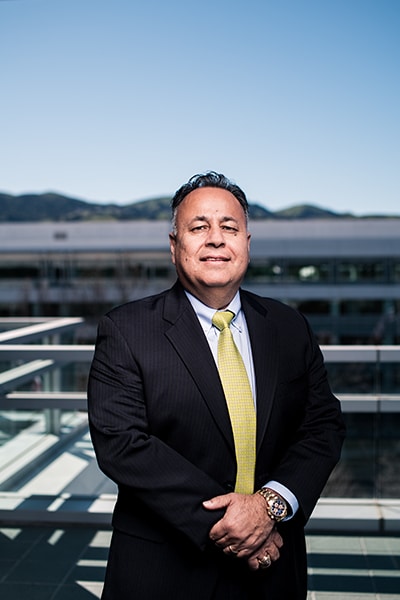|
Getting your Trinity Audio player ready...
|

In the fall of 2010, PG&E (Pacific Gas and Electric Company) and its customers experienced the unthinkable. A large diameter pipe ruptured and ignited in San Bruno, California, killing eight people. Ever since, the company has been on a mission to regain customer trust and establish itself as the safest, most reliable gas company in the United States.
“You can lose trust overnight,” says Jesus Soto Jr., PG&E’s senior vice president of gas operations. “It takes much longer to get it back, so community relations are a work in progress that we focus on every day.”
When the company set out to transform itself, it did so with a clear strategy of putting people and safety at the heart of its business. PG&E invested in system integrity and reliability, and it is continuously improving process effectiveness and efficiency.
To initiate momentum toward achieving those objectives, PG&E departed from simply complying with industry norms, such as internal monitoring and simply adhering to industry-established standards. After several years of benchmarking against best practices at numerous other companies and industries, the company earned ISO 5501 and PAS 55-1 certifications, two of the highest internationally recognized asset-management accreditations, in 2014. The company was recertified in both certifications in 2017.
Then, in 2015, it became the first US company to comply with the American Petroleum Institute Recommended Practice (API RP) 1173. In 2016, it was the first utility to receive the American Chemistry Council’s RC14001 certification for process safety; community communications; product safety; and occupational safety, health, environmental and security practices.
“As highly regulated as we are by state and federal guidelines, we’ve taken the position that if we’re dedicated to safe operations, we have to do more than what the regulations require,” Soto says. “There are very important differences between just being compliant and truly putting safety at the center of everything we do.”
PG&E has made substantial investments in innovative technologies. Picarro Surveyor is a gas leak survey technology that is one thousand times more sensitive than the equipment the company previously used. It has helped reduce minor leaks by 99 percent since 2010 without increasing the existing workforce. Soto points to this achievement as successfully increasing safety while staying mindful of the cost pressures on consumers.
A state-of-the-art Gas Control Center opened in San Ramon, California in 2013, which provides real-time data about operations across the enterprise. The center monitors flows, pressures, and alarms that may arise in a transmission system that consists of thirty-inch to thirty-six-inch pipes that operate at pressures of up to nine hundred pounds-per-square-inch. Operators view data on an a ninety-foot-long video wall and can communicate with field personnel through SmartBoards, which function as interactive whiteboards. They can control and isolate the flow of gas using automatic shutoff valves and remotely control components.
This has led to tremendous improvements in monitoring and maintaining the system. In 2015, when a bulldozer ruptured a pipe, the company identified the situation and halted gas flow in fourteen minutes. Overall improvements have resulted in a nearly 40 percent reduction in response time to customer concerns (such as smelling gas) between 2010 and 2017.
“You can lose trust overnight. It takes much longer to get it back, so community relations are a work in progress that we focus on every day.”
PG&E’s Gas Safety Academy opened in Winters, California, in the summer of 2017. The $85 million centralized training facility can accommodate up to 150 students a day and offers a virtual learning center, with tools such as backhoe simulators, a welding shop, a large flow lab that mimics the entire system, and a utility village, with simulated homes, pipelines, and meters that create both simulated and hands-on drills for a variety of maintenance and emergency situations.
A section of the ruptured San Bruno pipeline is prominently displayed in the Academy’s lobby. “We want the pipeline to be the first thing employees see when they arrive and the last thing when they leave,” Soto explains. “It’s a constant reminder of why they’re here.”
Keeping consumer convenience in mind, PG&E has developed the largest rolling stock of mobile compressed and liquid natural gas equipment in the country. This enables repair crews to take up to fifty thousand customers off-line during transmission line maintenance without interrupting their gas service.

Other safety innovations sound as if they have crossed into the realm of science fiction. One robotic in-line inspection tool is propelled inside pipelines by the gas stream. As it travels, it performs the equivalent of MRI scans to identify anomalies, like corrosion and structural defects. PG&E Research and Development is also working with engineers at NASA’s Jet Propulsion Laboratory to repurpose a methane detection device that was originally developed to explore Mars.
The company readily shares its innovations and benchmark processes with other utility companies. “Improving safety and system integrity shouldn’t be a competition, so we’re proud to share our practices and breakthroughs,” Soto says. “We want to help spread a very positive ripple effect.”
Even the Environmental Defense Fund has become a partner in an effort to help spread new strategies, techniques, and technologies that foster safety and reduce emissions. PG&E is also looking for ways to help California meet its aggressive carbon reduction goals by offering natural gas as an alternative to gasoline.
When asked about the financial savings resulting from a safer system, Soto is quick to correct the focus of the conversation. “Everything we do is aimed at building more robust, reliable, and safer operations, not at saving money,” he says. “When it comes to safety, it’s a never-ending pursuit.”

